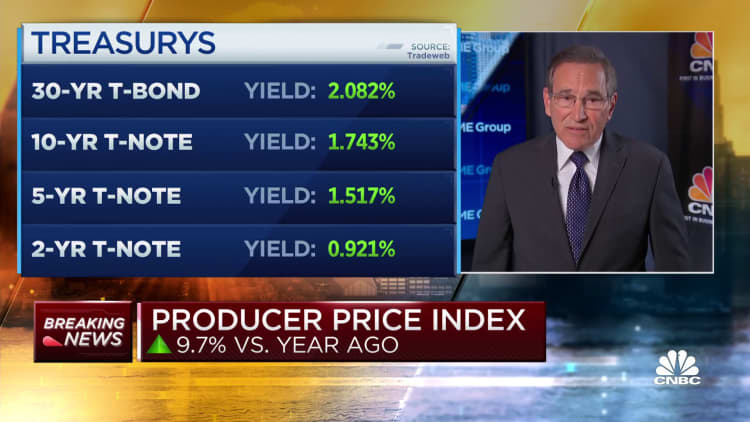
Wholesale prices rose less than expected in December but still set a new standard at a time when consumer inflation is running at a nearly 40-year high, the Labor Department said Thursday.
The producer price index, which measures prices received by producers of goods, services and construction, was up 0.2% for the month, half the 0.4% Dow Jones estimate.
However, on a 12-month basis, the index was up 9.7% to end 2021, the highest calendar-year increase ever in data going back to 2010.
The monthly gain was a sharp drop-off from the two previous months, which showed gains of 1% in November and 0.6% in October.
A separate report Thursday showed that initial jobless claims for the week ended Jan. 8 totaled 230,000, well above the 200,000 estimate and a considerable increase from the previous week's 207,000.
However, the longer-term trajectory for unemployment was lower.
Continuing claims, which run a week behind the headline number, fell by 194,000 to 1.56 million, the lowest level since June 2, 1973.
With the jobless level continuing to fall — the unemployment rate for December slid to 3.9% — markets have been more focused on inflation. Thursday's PPI reading came the day after the consumer price index, which measures prices paid at checkout for a swath of everyday goods and services, rose 7% year over year, the biggest 12-month gain since June 1982.
Excluding food, energy and trade, so-called core PPI increased 0.4% for the month, below the 0.5% estimate.
Final demand prices for food and energy both fell during the month, declining 0.6% and 3.3%, respectively. Trade prices rose 0.8% while transportation and warehousing costs were up 1.7%.
Goods prices actually declined 0.4% on the month but that was offset by a 0.5% rise in services. The Covid pandemic era has featured much stronger demand for goods, helping contribute to the surge in consumer inflation.
Federal Reserve officials are watching inflation data closely, and are expected to tighten policy later this year in response to rising prices and a jobs market getting closer to full employment.
"After nearly two years of accommodation, I think we can expect a fair amount of tightening in 2022," Philadelphia Fed President Patrick Harker said in remarks Thursday morning.
On the unemployment front, claims rose amid some seasonal noise left over from the holidays. Unadjusted claims totaled 419,446 for the week at a time when seasonal indicators already had pointed to a large increase.
Smoothing out for weekly volatility, the four-week average for claims was 210,750, an increase of 6,250 from the previous week but still below the pre-pandemic level.
"The speed of the drop in claims in November was flattered by favorable seasonals, and the payback is evident in the recent numbers," wrote Ian Shepherdson, chief economist at Pantheon Macroeconomics. "The seasonal issues will persist for another week or two, after which we expect claims to drop towards new cycle lows. The trend is heading south, just not as quickly as the data late last fall appeared to suggest."
The largely downward trend in claims has come amid labor force participation that remains well below the February 2020 pre-Covid levels and as enhanced and extended benefits expired.
Despite the unemployment rate's decline, the total employment level is about 2.9 million below where it was before the pandemic and the labor force level is smaller by nearly 2.3 million.


